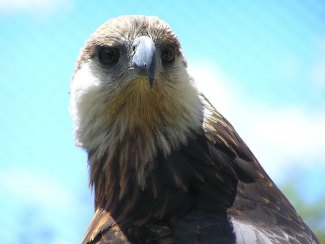Madagascar Fish Eagle - Haliaeetus vociferoides
By Frank Wouters, CC-BY-2.0, via Wikimedia Commons
Family: Accipitridae
Genus: Haliaeetus
Species: H. vociferoides
Madagascar Fish Eagles are among the rarest birds of prey on Earth and are the largest raptors on the island of Madagascar, to which they are endemic. They are closely related to Haliaeetus leucogaster (White-Bellied Sea Eagle), H. sanfordi (Sanford's Sea Eagle), and H. vocifer (African Fish Eagle). They are also a sister species to H. vocifer.
Physical Description:
Madagascar Fish Eagles are red-brown with a white throat and cheeks. The wings are dark brown and the tail is short and white and has black markings. There is heavy rufous streaking along the breast. The eyes are brown and the cere and legs are gray.
Juveniles have streaking on the head, pale underparts with buff-yellow markings, and a dark tail. They reach full adult plumage after five years.
Their call is similar to that of Haliaeetus vocifer (African Fish Eagle). It is a shrill "ko ko koy koy koy koy koy" that lasts for around a minute and is repeated every 5-12 minutes. If there are two eagles, the call is a "ki koy ki koy".
Size:
Length: 70-80 cm
Habitat and Distribution:
They live close to rocky coastal habitats, lakes, rivers, mangrove swamps, and wooded areas up to 90 km inland from the shore and from 0-1,200 meters above sea level. They depend on large trees for perches and nesting.
They are endemic to the island of Madagascar, occurring along 600 km of the western coast from 12°S to 21°S. Adults are sedentary, though juveniles disperse from breeding areas. BirdLife International estimates that there are 220 individuals over a range of 40,900 km².
Diet and Hunting:
Most of their diet consists of fish 25-35 cm long. They are taken close to the surface of the water, no deeper than 15 cm. Madagascar Fish Eagles also eat crabs, turtles, and birds. They still-hunt from a perch.
Reproduction:
The breeding season is from May-October and eggs are laid from late May to mid July. Pairs are relatively unproductive, with only 0.15 young being raised per territory; this is due to siblicide (Cainism) and the fact one third of all breeding attempts fail.
By Frank Vassen, CC-BY-2.0, via Wikimedia Commons
The nest is built out of sticks and placed in the fork of a tree or on a rocky cliff. It can be up to 120 cm across. 2 eggs are laid and incubated by both parents for 37-43 days, and the female does most of it. If nesting fails a replacement clutch may be laid; in either case, only one chick will survive since the older chick always kills the younger. Fledging takes 78-89 days.
46% of known breeding populations show cooperative breeding strategies, including polyandry, where the female mates with more than one male and all of those males attend to the nest. There can be up to four adults at a single nesting site.
Conservation:
Madagascar Fish Eagles are currently listed as Critically Endangered by BirdLife International. That listing is under the assumption that the population has experienced a rapid decline, but recent research shows that there has not been a significant decline and the population has been small for hundreds, perhaps thousands of years. If the population is stable, even at low numbers, and there are 350 or more individuals (which has been suggested) the species should be downlisted to Endangered.
Conservation measures undertaken include studying the breeding population, enforcing existing laws, and releasing birds raised in captivity that had been rescued from siblicide. Conservation measures proposed include monitoring the population size and distribution, increasing awareness in the local community, managing the wild population, and researching the Madagascar Fish Eagles' breeding territories, survival rates, and reproduction.
Taxonomy:
Haliaeetus vociferoides is closely related to Haliaeetus leucogaster (White-Bellied Sea Eagle), H. sanfordi (Sanford's Sea Eagle), and H. vocifer (African Fish Eagle), and is a sister species to H. vocifer
Other Names:
Orel madagaskarský (Czech), Madagaskarflodørn (Danish), Madagascar-zeearend (Dutch), Madagaskari merikotkas (Estonian), Madagaskarinmerikotka (Finnish), Pygargue de Madagascar (French), Madagaskarseeadler (German), Aquila pescatrice del Madagascar (Italian), Madagasukaruumiwashi (Japanese), Gasserflodørn (Norwegian), Bielik madagaskarski (Polish), Pigargo de Madagascar (Spanish), Madagaskarhavsörn (Swedish).
Video of a Madagascar Fish Eagle:
References:
http://www.arkive.org/madagascar-fish-eagle/haliaeetus-vociferoides/
http://avibase.bsc-eoc.org/species.jsp?avibaseid=A877BECE07EDEB30
BirdLife International (2012) Species factsheet: Haliaeetus vociferoides. Downloaded from http://www.birdlife.org on
09/01/2012.
http://elibrary.unm.edu/sora/jrr/v036n04/p00280-p00286.pdf
Global Raptor Information Network. 2012. Species account: Madagascar Fish Eagle Haliaeetus vociferoides. Downloaded from
http://www.globalraptors.org on 9 Jan. 2012
http://ibc.lynxeds.com/species/madagascar-fish-eagle-haliaeetus-vociferoides
BirdLife International 2010. Haliaeetus vociferoides. In: IUCN 2011. IUCN Red List of Threatened Species. Version 2011.2.
www.iucnredlist.org. Downloaded on09 January 2012.
http://www.planetofbirds.com/accipitriformes-accipitridae-madagascar-fish-eagle-haliaeetus-vociferoides
http://raptors-international.org/book/raptors_in_the_modern_world/Langrand_Meyburg_1989_269-278.pdf
Ferguson-Lees, James, and Christie, David A. Raptors of the World. Houghton Mifflin Company, 2001.

